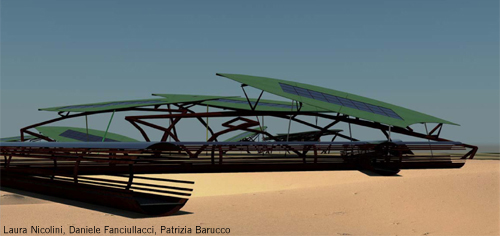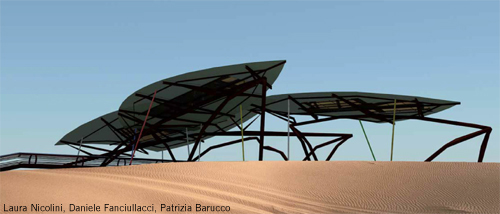arsprogetti
Laura Nicolini, Daniele Fanciullacci, Patrizia Barucco
Designed for Site #3 in Abu Dhabi, on Airport Road near Masdar City.

Design Submission for the 2010 Land Art Generator Initiative Design Competition
Artist’s descriptive text:
The installation is the result of choices between artistic sensitivity and architectural culture, as well as of technical and scientific competence.
The artistic project was inspired by Master Marco Gastini’s work. Gastini in born in Turin in 1938. His works and installations have been exhibited in many museums and galleries worldwide. The leitmotiv of his artistic activity is the inspiration from stratification and to the “fossil” essence of objects. In his installations the key factor is the desire to create tensions.

The idea of this intervention is to create an artistic installation inspired by the local organic world and, at the same time, able to communicate the contemporary language of architecture. In this installation nature inspires artifice. Between “natural” and “artificial” a series of matches and dependencies are created, which create mutual constraints.
Therefore, the guidelines of the composition were:
1) TO CATCH THE PECULIARITIES OF THE SITE;
2) TO DEFINE THE SITE THROUGH ARCHITECTURAL ELEMENTS SUGGESTED BY NATURE;
3) “[…]TENSIONS, STRATIFICATIONS AND SEEMING CASUALITY TO DEFINE THE RELATIONS BETWEEN DIFFERENT ELEMENTS […]” by M. Gastini.
Concepts and elements of the new landscape redrawn in modern terms:
We wanted to enhance the desert character of the place, reshaping the area with three big dunes, on which there are some installations made by elements in tension between them.
These dunes are scenic platforms where visitors can gaze at the new landscape during day and in particular during night.
Groups of “fallen” leaves lied down on each dune are sustained by a complex structure, that looks like the mimetic insects.
There are also long sticks, lied down in apparent randomness, used to assemble the different parts of the reshaped site and they are suitable sheltered paths, through which you can reach the installations placed on the top of the dune.

Characteristics and material of the installation elements:
The “leaves” are photovoltaic ceiling made with two different types of photovoltaic technologies:
1. Middle: polycrystalline silicon photovoltaic panels particularly dimensioned; and
2. Around: textile Sunshade.
These leaves shade the place on which they lay and they allow the complete use for different aims: temporary expositions, teaching activities and at the same time they serve as locations for movies or spots, fashion shows, trading activities and more.
The centre of the leaves:
– The leaves are sustained by structural backs in corten steel with beams. This complex structure is tested by a tension analysis.
The corten steel allows wide flexibility in the choice of support points and the structural development and it has the merit to be particularly resistant to corrosion. It appears from the outset in a color “copper-burnished”, which is an excellent placement for a chromatic insert in the landscaping.
– The whole structure is further tightened by special “light bolts” with steel core. These are the most surprising elements, both for their illumination and coloration mode that give a particular night impression to the site. They light up thanks to a technology that combines the use of L.E.D. (Light-Emitting Diode) and L.E.P. (Low Emissivity luminescent Polymers, used in the coating of “light bolts”).
– The covered walkways are designed with metal frame and bricks particularly shaped to the arched roof for the sunscreens that allow to filter light and wide visibility. The entire surface area is coated with CIGS Thin Film Material.
These pathways are lit at night with an intense blue light produced with LED technology.

The installation achieves an overall height of 32 m, remaining well below the 55 m max. It is never lowers below the actual level of the soil and does not create problems to the aquifer.
The modeling of soil use only local sand: in this way the visual impact is limited and increases the contextualization of art installation.
The materials used for the installations are:
CorTen steel
Prefabricated bricks elements
PV modules
Textile Sunshade
CIGS Thin Film Material
Related Posts
1 Comment
Add comment Cancel reply
This site uses Akismet to reduce spam. Learn how your comment data is processed.

[…] way the visual impact is limited and increases the contextualization of art installation. Source: Land Art Generator Initiative Reageer […]